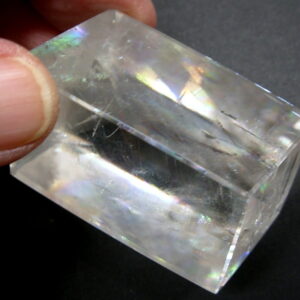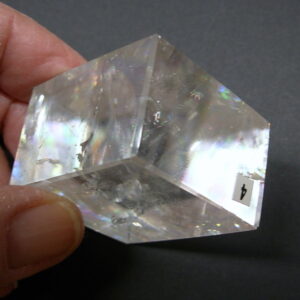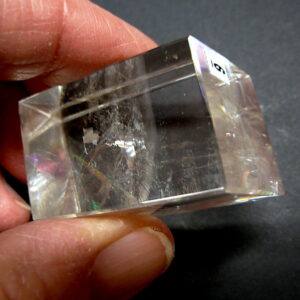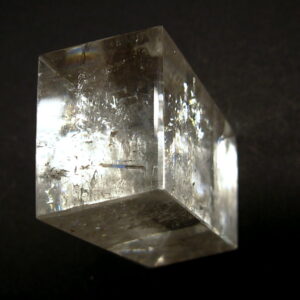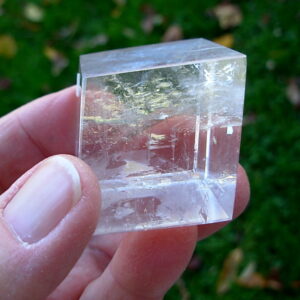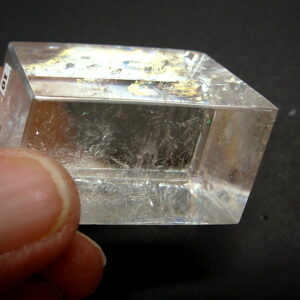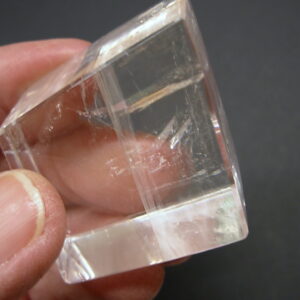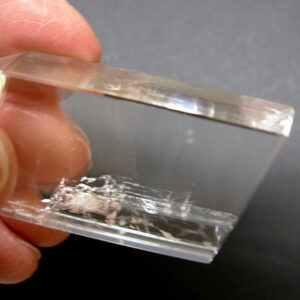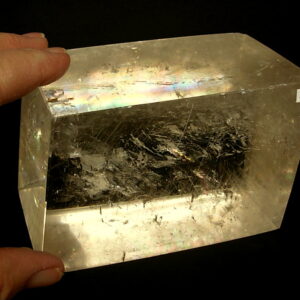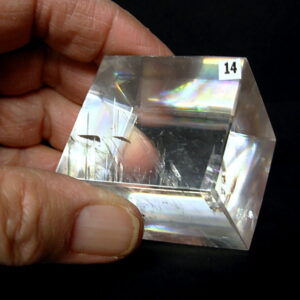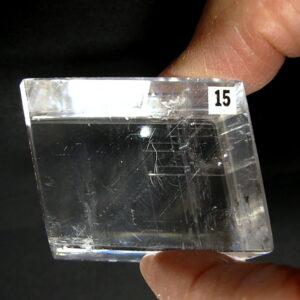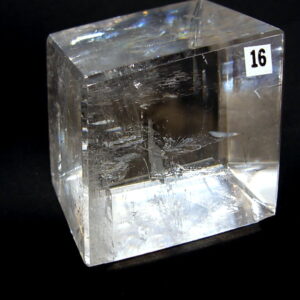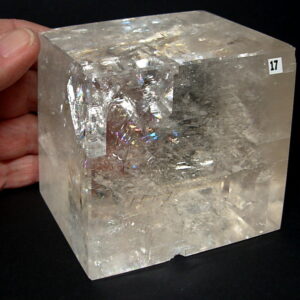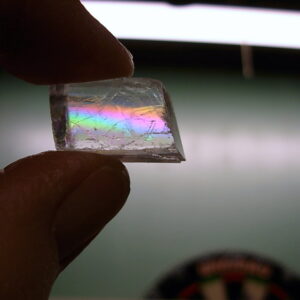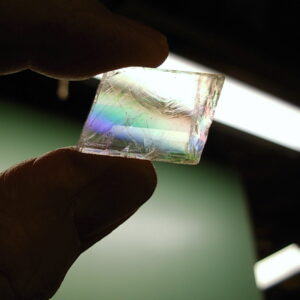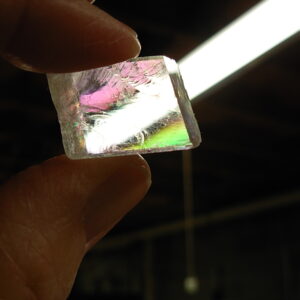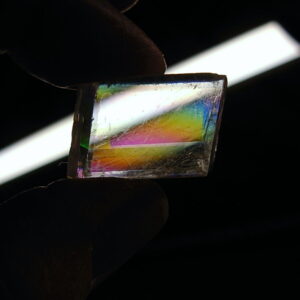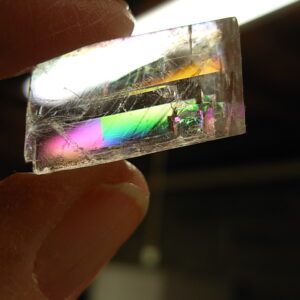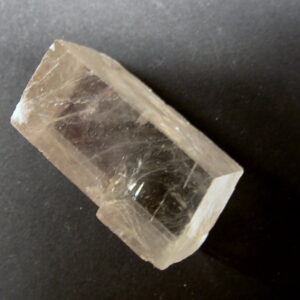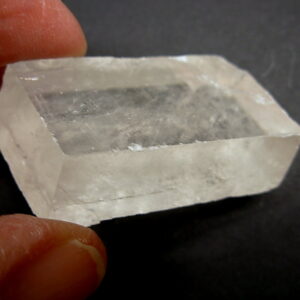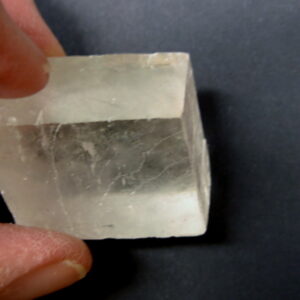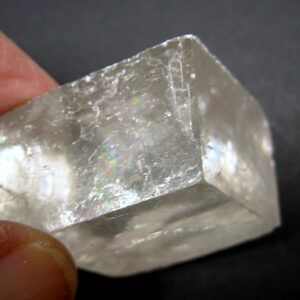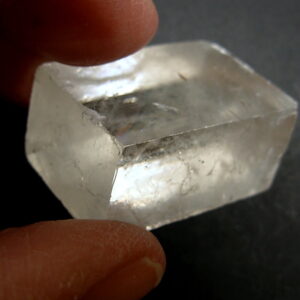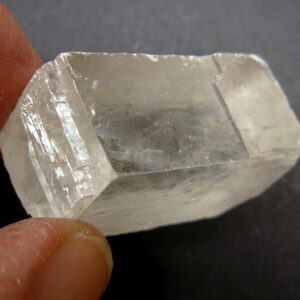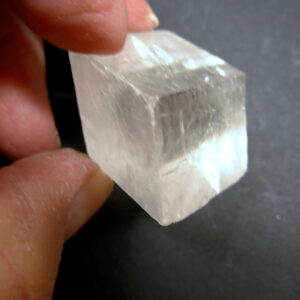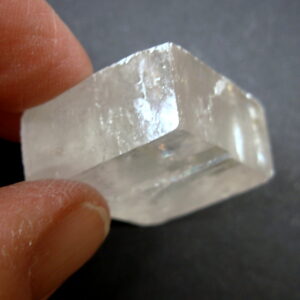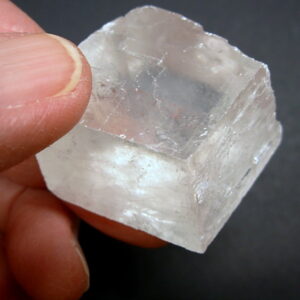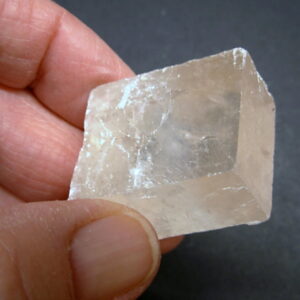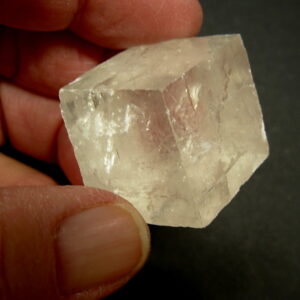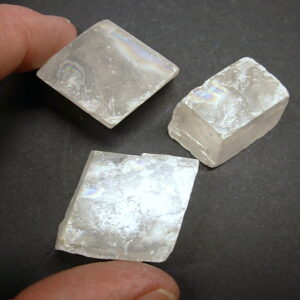"Iceland Spar" (aka) Optical Calcite
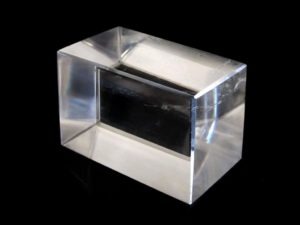
Brazilian Optical Calcite beautifully ground and Polished in Germany
Calcite, Iceland Spar, Optical Calcite
This variety of Calcite is called "Iceland Spar", which is basically clear cleaved fragments of completely colorless (ice-like) calcite. Originally discovered in and named after Eskifjord, Iceland. The Iceland spar displays the classic cleavage form of calcite, the rhombohedron. Iceland Spar is used for optical equipment and during World War II it was an extremely important mineral that was used in the sighting equipment of bombardiers and gunners. Our specimens come from the locations currently producing the most interesting specimens for collectors. We are always looking for more locales.
History
“A secret mine in the mountains west of the Salton Sea contained the only available source of a particular calcite crystal needed to make the famous “Norden Bombsight”. This transparent crystal formation is also known as Iceland Spar because it is found in cavities in the solidified lava of which Iceland is made. The war in Europe had made shipping in the North Atlantic very precarious and the United States needed another source of this precious commodity. The Norden bombsight was one of the most important military secrets of World War II; it made possible the very accurate European bombing raids which helped bring the war to a close. It was so advanced that bombardiers had to take an oath to protect its secrecy with their lives. Arthur LaLonde remembers that one of his first assignments in the military was to search, with four other men, the snowy summit of Mt. San Jacinto for the Norden bombsight carried on a plane that had crashed there. Locals who worked the mine remember that it was guarded by Marines and worked around the clock. The mine is now within the boundaries of Anza-Borrego State Park, north of the Salton City Borrego Springs highway.” Source: The Periscope 2001 - Publication of the Coachella Valley Historical Society
Properties
Iceland spar demonstrates the unique property of calcite called birefringence (double refraction). Double refraction occurs when a ray of light enters the crystal and due to calcite's unique optical properties, the ray is split into fast and slow beams. As these two beams exit the crystal they are bent into two different angles (known as angles of refraction) because the angle is affected by the speed of the beams. A person viewing into the crystal will see two images ... of everything. The best way to view the double refraction is by placing the crystal on a straight line or printed word. The result will be two lines or two words visible through the calcite. The thickness and the angle of the Calcite determines the distance between lines or text as can be seen in the photos in our listings. Turning or rotating the calcite increases or decreases the space between the two lines or words (double refraction) that this mineral is famous for. Different sides of the rhomb give different separation distances for the double refraction as well. These are very educational and interesting pieces!
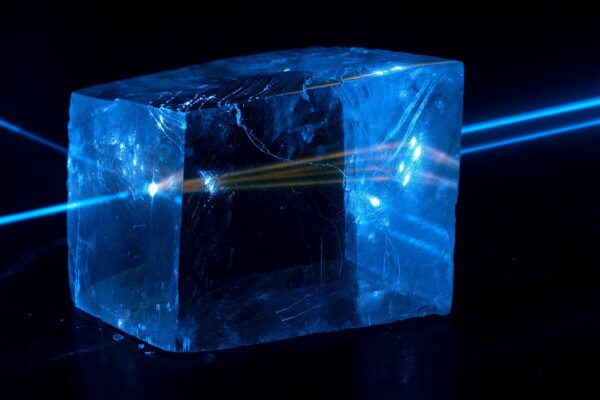
Fluorescence and birefringence of 445 nm laser in optical calcite crystal
wikimedia fluorescence in calcite
Photo by Jan Pavelka - Own work, CC BY-SA 4.0 https://commons.wikimedia.org/w/index.php?curid=45341180
A crystal of Iceland spar has two very interesting properties. First, it is a natural polarizing filter. Second, because of its natural polarization, Iceland spar is birefringent, meaning light rays entering the crystal become polarized, split, and take two paths to exit the crystal – creating a double image of an object seen through the crystal.
Iceland spar is a highly transparent variant of calcite. It can be easily split into rhomboids with a vitreous luster, having angles of 105° and 75° between the sides. When one looks through a clear crystal, two images are seen due to its double refraction. The Helgustaðir quarry in Reyðarfjörður, East Iceland is famous worldwide as the type locality (first discovered location) of a highly transparent variety of calcite crystals, where from around 1780, it got the name “Iceland Spar“. In Europe in 1669, the Danish scientist Rasmus Bartholin (1625-1698) discovered and studied double refraction in calcite. Other early scientists who studied this crystal included Christiaan Huygens (1629-1695), Sir Isaac Newton (1643-1727), and Sir George Stokes (1819- 1903). Originally discovered in and named after Eskifjord, Iceland, where in the 19th century giant crystals of calcite up to 25 feet were found.
Iceland spar has been found in many localities around the world such as the long-closed Helgustadir Mine, in Eskifjord, Iceland; Santa Eulalia, Chihuahua, Mexico; The Harding Mine, in Dixon, New Mexico; The Cabacal Mine in Mato Grosso, Brazil; St. Andreasberg, Harz Mountains, Germany; Pribram, Bohemia, Czech Republic; People's Republic of China and most recently Madagascar.
Pure Iceland Spar is clear or colorless, but it is found in a great variety of colors owing to impurities. Chemically it is calcium carbonate, CaCO 3 , but it frequently contains manganese, iron, or magnesium in place of the calcium. Premium quality Iceland Spar that is clear is most often referred to as Optical Calcite because of its optical and scientific uses. Quality clear Optical Calcite may sell for up to $2.00 per gram. Colored Iceland spar is found in various shades of yellow, green, pink, lavender and more and sells for less.
One of the most interesting and possibly the earliest practical use of Iceland Spar was thought to be by the Norsemen and the Vikings as a navigation tool. The Vikings were pirates and warriors while the Norsemen were noble people who engaged in farming, trade and were also rulers. Did the vikings use iceland spar to navigate?
Iceland Spar Used in Navigation
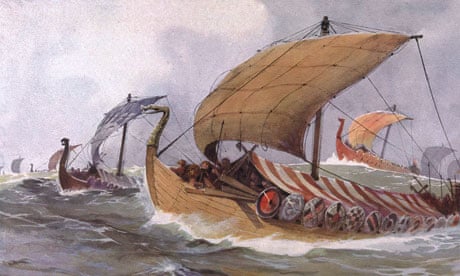
Long celebrated as master shipbuilders and seafarers, the Vikings ruled the waters of the North Atlantic from 900 to 1200 A.D., regularly sailing their longboats for hundreds of miles over open water to their colonies in Iceland and Greenland. On clear days, they used a sundial-like instrument called a sun compass to guide their way, with great accuracy. But scientists have struggled to answer a simple question: How did the Vikings navigate when it was cloudy or foggy? Many centuries ago, the Vikings sailed from Scandinavia to America without the use of magnetic compasses, astrolabes, maps or any other known device. Yet they still managed to find their way in spite of the clouds, fog, and long summer twilights characteristic near the Polar Regions. Viking legends attribute their navigational success to the use of mysterious, glowing “sunstones” to find the position of the sun and set the ship’s course even on cloudy days. Although still controversial, many researchers now believe that these “magical sunstones” were in fact Iceland spar. There is good evidence that the Vikings used the polarizing effect of Iceland spar to navigate the North Atlantic.
The process of pinpointing the location while at sea using Iceland Spar as the "Sunstone", contrary to assumptions, is quite simple and easy to comprehend. Mark a spot on the top surface of the sun stone. When viewed from the bottom surface of the mineral, a reflection of the spot is created automatically on the top of the surface. In order to pinpoint the suns location, the mineral is rotated in such a way that the spot and its reflection match each other’s brightness. This helped the Vikings to navigate at sea with a very high rate of accuracy.
When Iceland spar splits light into two polarized rays, the two different images will have different brightness depending on the polarization. Because sunlight is polarized when it enters the Earth’s atmosphere, it is possible to change the orientation of a piece of Iceland spar to determine the direction of the sun. This is done by moving the crystal until the relative brightness of the two images are equal, which only happens when the crystal is aligned to the sun. This is possible even when the Sun is hiding behind clouds or just below the horizon.
However, it can be very difficult to determine when the two images are of equal brightness. A recent study suggests that the Vikings may have built a simple device to better use the sunstone. The crystal is covered with a solid screen with a small hole in its center, and a pointer. When light passes through the hole onto the crystal, a dark surface below it receives the projection of the double image for comparison. Experiments showed that by rotating the device until the two images were equally bright, the sun’s position on a cloudy day could be determined to within 1º of accuracy, and that it is also very accurate even when the sun is below the horizon.
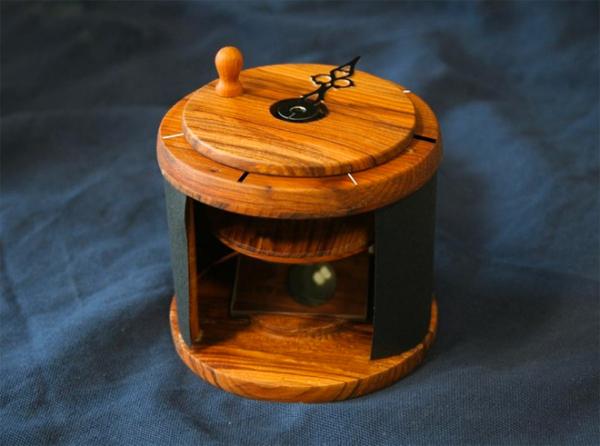
Physicist Guy Ropars and a team at the University of Rennes in France developed a modern compass based on the Viking sunstone. It uses an optical calcite (Iceland Spar) crystal mounted inside a wooden box to locate the sun in the sky. The two beams of light can be seen on the reflective surface inside. © Guy Ropars, University of Rennes. Ropars is currently working with a US company to commercialize this compass. (Photo by Ropars)
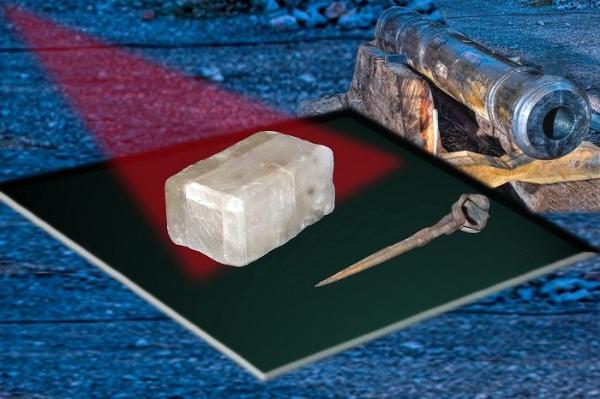
Researchers say this crystal found at the Alderney shipwreck near the Channel Islands
could prove fabled Viking sunstones really did exist.
(Image: © Alderney Museum )
Now, scientists using an experimental setup with a similar crystal to the one found in a shipwreck have shown that such stones could indeed have helped the Vikings navigate from Norway to North America.
“The Vikings could have discovered this, simply by choosing a transparent crystal and looking through it through a small hole in a screen,” study researcher Guy Ropars said. “The understanding of the complete mechanism and the knowledge of the polarization of light is not necessary.”
It’s believed the Vikings used a common calcite crystal, called Icelandic spar. This stone has the special property of birefringence that allows light to get polarized and broken into two – “ordinary” and “extraordinary” beams – when sunlight enters the crystal. Vikings might have calibrated calcite crystal sunstones by scanning them across a clear sky and noting the sun’s position when the crystal brightened. They could then repeat the trick to locate the sun when it was no longer visible by guiding themselves after the same reference point, subsequently marked.
A team of researchers, led by Guy Ropars, at the University of Rennes in France, put the calcite crystal to the test. For their set-up, the scientists used Icelandic spar found aboard an Elizabethan warship that sank in 1592 near Alderney in the Channel Islands. This find suggests the possibility that this navigational technology may have persisted even after the invention of the magnetic compass.
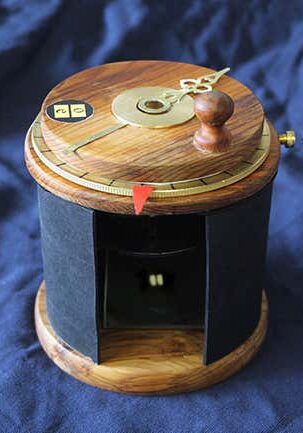
The sun compass
The Rennes researchers made a prototype sunstone compass. They covered the crystal with an opaque sheet that had a hole in the center. The calcite worked particularly well (even with the naked eye), even when the sun was beyond the horizon and after the stars came out. Further tests showed that they could pinpoint the sun’s position with an accuracy of one degree in either direction
“Such sunstones could have helped the Vikings in their navigation from Norway to America, as the magnetic compass had yet to be introduced in Europe,” Guy said. A crystal measuring 3cm (1.18 inches) on each side would have been large enough to work, he added.
Onboard the Elizabethan vessel conventional magnetic compasses would’ve probably been prone to significant error, as even a single canon was enough to disrupt the magnetic field. The research conducted by Guy and his team of researchers confirms that the Iceland Spar sunstone is more than a simply myth, and moreover that Vikings had the necessary navigation technology for trips across the Atlantic. All of this though, is not proof that the Vikings used sunstones. It is only evidence that the technology could have worked. Nobody really knows what the Vikings' navigation practices were.
Sources; https://www.theguardian.com/science/2011/nov/02/sunstones-vikings-navigate-america https://www.smithsonianmag.com/smart-news/simulation-suggest-legendary-viking-sunstones-could-have-worked-180968710/ (Photos by Ropars, Almay and Jan Pavelka)
-
Optical Calcite #01 from Brazil Polished 59g
$96.76 Add to cart -
Optical Calcite #02 from Brazil Polished 65g
$82.46 Add to cart -
Optical Calcite #03 from Brazil Polished 74g
$70.03 Add to cart -
Optical Calcite #04 from Brazil Polished 84g
$78.96 Add to cart -
Optical Calcite #06 from Brazil Polished 58g
$95.94 Add to cart -
Optical Calcite #07 from Brazil Polished 78g
$127.92 Add to cart -
Optical Calcite #08 from Brazil Polished 92.5g
$86.95 Add to cart -
Optical Calcite #10 from Brazil Polished 72g
$89.28 Add to cart -
Optical Calcite #11 from Brazil Polished 87g
$142.68 Add to cart -
Optical Calcite #12 from Brazil Polished 53g
$127.74 Read more -
Optical Calcite #13 from Brazil Polished 1.069 kg
$235.00 Add to cart -
Optical Calcite #14 from Brazil Polished 125g
$155.12 Add to cart -
Optical Calcite #15 from Brazil Polished 97g
$159.08 Add to cart -
Optical Calcite #16 from Brazil Polished 118g
$146.32 Add to cart -
Optical Calcite #17 from Brazil Polished 975g
$325.00 Add to cart -
Optical Calcite Clear #13 Rough 6.5g
$16.66 Add to cart -
Optical Calcite Clear #14 Rough 9g
$17.16 Add to cart -
Optical Calcite Clear #15 Rough 11.5g
$19.26 Add to cart -
Optical Calcite Clear #16 Rough 11.5g
$16.81 Read more -
Optical Calcite Clear #17 Rough 8.5g
$14.99 Add to cart -
Optical Calcite Clear #18 Rough 16g
$15.04 Add to cart -
Optical Calcite Clear #19 Rough 21.5g
$20.21 Add to cart -
Optical Calcite Iceland Spar #20 Rough 25g
$6.25 Read more -
Optical Calcite Iceland Spar #21 Rough 34g
$8.50 Read more -
Optical Calcite Iceland Spar #22 Rough 35.5g
$8.87 Add to cart -
Optical Calcite Iceland Spar #23 Rough 23.5g
$5.87 Add to cart -
Optical Calcite Iceland Spar #24 Rough 27g
$6.75 Add to cart -
Optical Calcite Iceland Spar #25 Rough 32g
$8.00 Add to cart -
Optical Calcite Iceland Spar #26 Rough 23.5g
$5.87 Add to cart -
Optical Calcite Iceland Spar #27 Rough 37.5g
$9.37 Add to cart -
Optical Calcite Iceland Spar #28 Rough 27g
$6.75 Add to cart -
Optical Calcite Iceland Spar #29 Rough 31g
$7.75 Add to cart -
Optical Calcite Iceland Spar #30 Rough 3 pc Set 45.5g
$9.10 Add to cart


